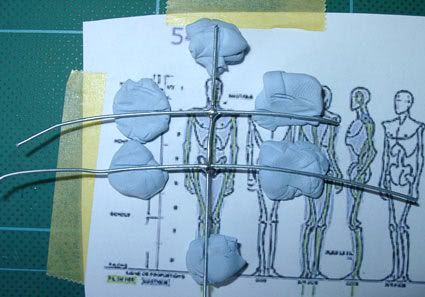quang
A Fixture
Hello Planeteers,
As you may (or may not) know, I usually work in 120mm and bigger scale (for the busts).
Following some friendly but nevertheless muscular persuasion , I finally tried my hand at a smaller scale: 90mm or 1/20. Changing scale can be quite a stressful experience, so I decided to record it in photos to share with you.
, I finally tried my hand at a smaller scale: 90mm or 1/20. Changing scale can be quite a stressful experience, so I decided to record it in photos to share with you.
It's NOT a detailed article on sculpting (like Gary's authoritative s-b-s). Rather a string of photographic sequences depicting the making of a figure. Some of you may found the order of the sequences disturbing but it works for me. May be it will work for you too.

The first thing I did was to resize my anatomical charts to the new scale. Chart courtesy of pF member Aeronaudts.
A new 90mm mannequin was sculpted and cast for future projects. The casting was fitted with wire and assembled using the chart and the dividers.
Next step: posing the figure.
Any comment, question, remark is very welcome, as usual.
Cheers,
Quang
As you may (or may not) know, I usually work in 120mm and bigger scale (for the busts).
Following some friendly but nevertheless muscular persuasion
It's NOT a detailed article on sculpting (like Gary's authoritative s-b-s). Rather a string of photographic sequences depicting the making of a figure. Some of you may found the order of the sequences disturbing but it works for me. May be it will work for you too.

The first thing I did was to resize my anatomical charts to the new scale. Chart courtesy of pF member Aeronaudts.
A new 90mm mannequin was sculpted and cast for future projects. The casting was fitted with wire and assembled using the chart and the dividers.
Next step: posing the figure.
Any comment, question, remark is very welcome, as usual.
Cheers,
Quang






